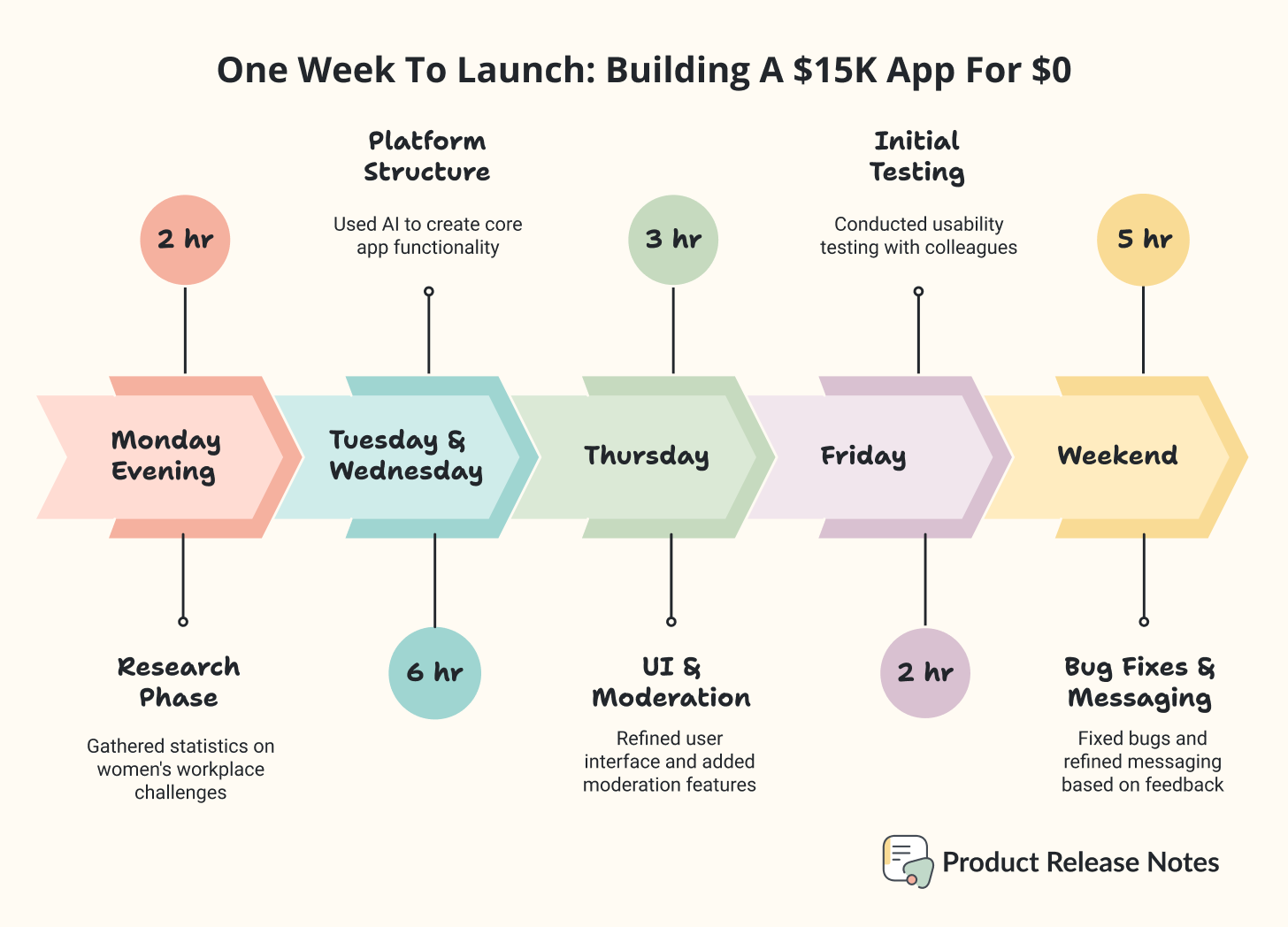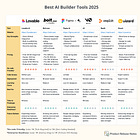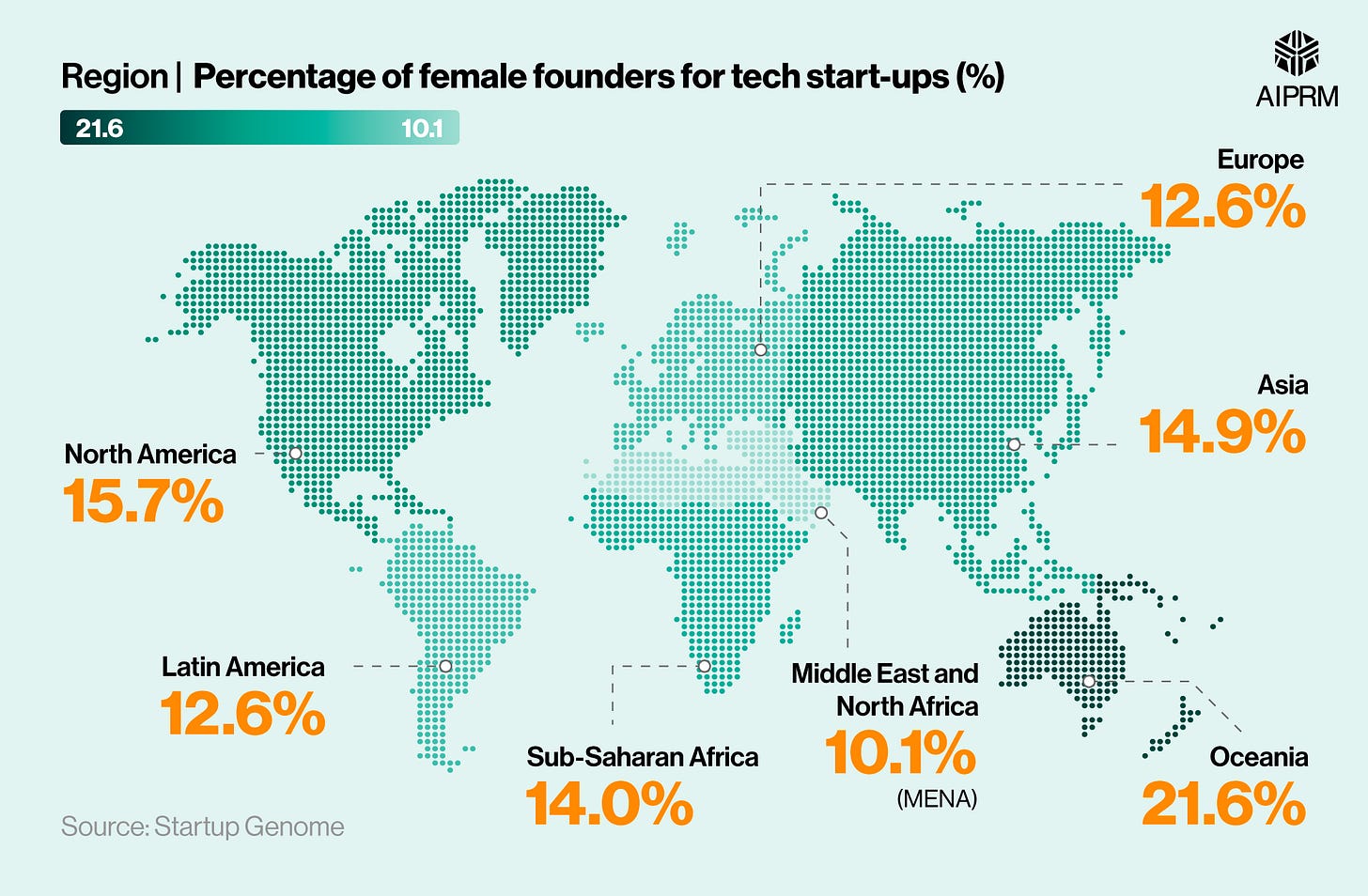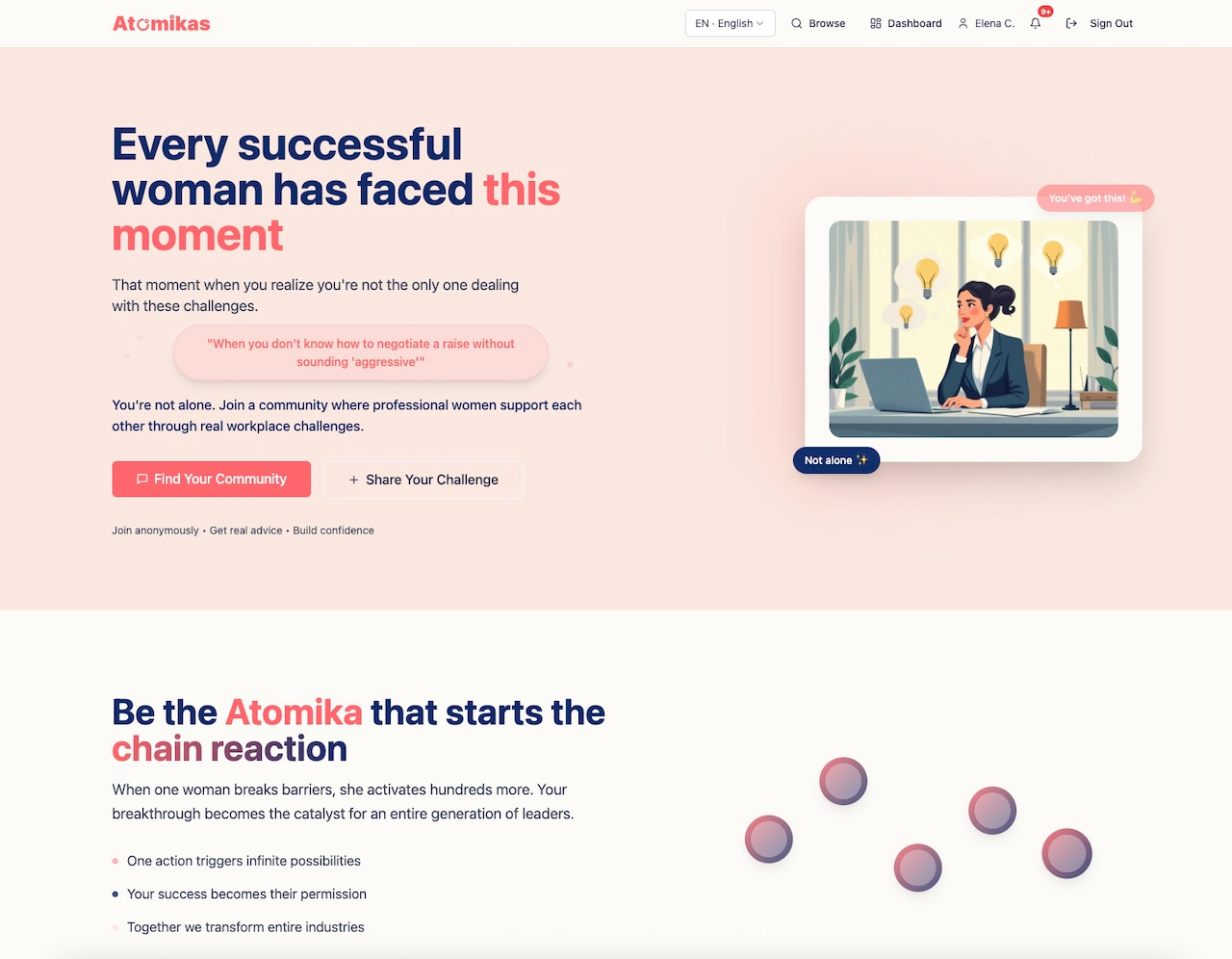I Built a $15K App for $0 And It Might Change How Women Navigate Tech Careers
Using AI tools, I transformed a career support idea into a working prototype without hiring developers, learning to code, or spending thousands. Here's the honest breakdown of what it took.
This is the first part of a series I am creating on how to validate any idea with AI. Subscribe so you don’t miss anything.
Six months ago, I had an idea that felt important but impossible.
I wanted to create a platform where women could anonymously share workplace challenges and get real advice from others who’d walked the same path. Think of workplace situations like negotiating salary without sounding “aggressive,” dealing with colleagues who take credit for your ideas, or managing a team that doesn’t respect your authority.
The problem wasn’t the idea. The problem was everything else.
Traditional app development would have meant months of planning, hiring developers at $15,000+ minimum, and investing significant money before getting any user feedback. As a product manager in Latin America, I knew the market needed this, but I didn’t have the budget for traditional validation.
Then I discovered something that changed my entire approach to product development.
The Week That Changed Everything
Let me be realistic about timelines here. Despite what you see in those “built in 30 minutes” social media posts, creating something meaningful takes more than a coffee break. But it doesn’t have to take months either.
Here’s what actually happened over one productive week:
1️⃣ Monday Evening (2 hours): Research phase using Perplexity to gather statistics about women’s workplace challenges and existing solutions.
The data: 80% of women struggle with low self-esteem and shy away from self-advocacy at work, while 75% of female executives have experienced imposter syndrome.
2️⃣ Tuesday & Wednesday (6 hours total): Used Lovable to create the basic platform structure. Wrote prompts describing the core functionality: anonymous posting, response systems, category organization, and easy user registration. The AI generated the initial code, but I spent considerable time refining the prompts to get the exact functionality I wanted.
3️⃣ Thursday (3 hours): Refined the user interface, added the “Atomikas Journey” concept, and implemented basic content moderation features. This involved multiple iterations, AI tools are powerful, but they don’t always interpret your vision correctly on the first try.
4️⃣ Friday (2 hours): Initial testing with two trusted colleagues from different tech backgrounds, a UX designer and a product manager. Their feedback revealed critical usability issues I hadn’t anticipated.
5️⃣ Weekend (5 hours): Applied their technical feedback to fix common bugs: mobile responsiveness issues, form validation problems, and navigation inconsistencies that would have frustrated real users. Also refined the messaging based on their suggestions about clarity and tone.
Here is a special shout out to
, because she helped me review and identify the places where AI generated content with gender bias, judgments, and much more. Thanks, Katrina! 🙏
Total investment: Approximately 18 hours spread across one week, plus $0 in platform costs. I’m not paying anything at this point.
Compare this to traditional development: months of planning, $15,000+ in developer costs, and complex technical infrastructure setup before getting any user feedback.
The AI Prototyping Revolution Is Real
The numbers behind this shift are staggering. The AI prototyping market grew to $1.48 billion in 2025, and is projected to reach $3.42 billion by 2029. But these aren’t just vanity metrics.
What this represents is a fundamental democratization of innovation.
Tools like Lovable, Bolt.new, Replit, and v0 have eliminated the technical barriers that historically prevented non-developers from testing their ideas. In 2024, 75% of no-code apps meet or exceed performance expectations, proving these platforms can deliver real functionality.
For women entrepreneurs specifically, this shift addresses a critical funding gap. Research shows that female-focused startups experience 40-45% less early-stage support than male-focused ventures. When you can validate an idea for under $50 instead of $15,000, that funding barrier becomes significantly less relevant.
The Tools That Made It Possible
Let me break down the specific AI tools that enabled this rapid prototyping:
Lovable (Primary Platform): Transforms plain English descriptions into working web applications. What sets it apart is that you own the actual code, it automatically publishes to GitHub and includes security scanning. For non-technical founders, this eliminates the “black box” problem of other no-code platforms.
Perplexity (Research): Instead of spending hours googling statistics and market research, I used AI-powered search to gather comprehensive data about women’s workplace challenges, existing solutions, and market validation in minutes.
DeepL (Language Refinement): As a non-native English speaker building for both Latin American and global markets, AI translation ensured my messaging was clear and culturally appropriate.
The total monthly cost for all these tools combined is less than what I’d spend on coffee. The accessibility is genuinely revolutionary.
What Actually Got Built
Atomikas platform isn’t just a mockup, it’s a functional application with real features:
Core Functionality:
Anonymous posting system where users can share workplace challenges
Category-based organization (workplace dynamics, leadership challenges, compensation negotiation)
Response and selection system to surface the most helpful advice
Bilingual support for Spanish and English markets
Mobile-responsive design that works across devices
The “Atomic Journey” Concept:
I developed a four-stage transformation model that gives the platform its unique positioning:
Personal Activation - Taking action despite fear 🙈
Energy Release - Success becomes visible to others ⚡️
Chain Reaction - Others are encouraged to act ⚛
Exponential Multiplication - Systemic change is activated 🪐
This isn’t just marketing copy, it’s based on real research about how women’s success in the workplace creates ripple effects that benefit entire.
Real Challenges Behind The Hype
Here’s what the “build it in a weekend” success stories don’t tell you: creating the prototype was the easy part.
The actual challenges began immediately after deployment:
Technical Limitations: AI-generated code works for prototypes, but scaling requires real engineering. As my article on technical debt warns, “teams using these tools without guardrails see 3x more production delays and higher refactoring costs”.
Content Moderation: Creating a safe space for women to share vulnerable workplace experiences requires sophisticated moderation that AI tools can’t automatically provide. (This part I need to figure it out.)
Community Building: Getting people to trust a new platform enough to share professional challenges is exponentially harder than building the platform itself.
Cultural Nuances: Building for Latin American markets means understanding regional workplace dynamics that no AI tool can fully capture, and globally, cultures are not the same.
The technical feasibility was solved in a week or so. The human challenges are ongoing.
The Numbers That Are Driving This
The motivation for this platform comes from sobering workplace statistics that affect millions of professional women:
➡️ Product Management Specifically: Women occupy about 30% of product management roles, outpacing the roughly 20% female representation in broader tech. However, the numbers drop dramatically at senior levels, fewer than one in five director-level or above product roles are occupied by women.
➡️ Systemic Challenges: Research reveals that 72% of women have experienced gender bias affecting promotion opportunities, 58% don’t have equal access to networking, and 70% believe promotion processes are unfair.
➡️ Regional Impact: In Latin America specifically, traditional gender roles create additional barriers where women are expected to prioritize family care, have limited access to mentorship, and face cultural reluctance to discuss workplace conflicts openly.
These aren’t abstract problems! They represent the daily reality for millions of professional women who need practical solutions, not just awareness campaigns.
The Real Business Model Question
Building the prototype taught me something important about AI validation: technical feasibility and market viability are completely different challenges.
AI tools proved I could build a functional platform quickly and cheaply. They didn’t prove that women would use it, trust it, or find it valuable enough to become active community members.
The current validation approach:
Beta testing group: 25 selected women across different industries and experience levels
Feedback cycles: Weekly testing sessions to identify friction points
Community building: Focus on trust and safety before feature development
Bilingual approach: Testing Spanish and English versions simultaneously
The goal isn’t to scale immediately, it’s to prove genuine demand exists before investing in more sophisticated development.
What This Means For Your Own Ideas
Whether you’re validating a women’s career platform or any other concept, the lessons are transferable:
✅ Technical barriers no longer excuse inaction. With AI prototyping tools, you can build functional demos in hours, not months. The bottleneck has shifted from “can we build it?” to “will people want it?”
✅ Focus validation energy on the hardest part: community building, user trust, and market demand. These remain fundamentally human challenges that require human solutions.
✅ Start with clear constraints. My week limit forced me to focus on core functionality instead of getting lost in feature complexity.
✅ Document the process. Your validation approach becomes a case study for future projects, regardless of outcome.
✅ Plan for multiple scenarios. Success, failure, and pivot opportunities are all valuable information when you’ve minimized upfront investment.
The Bigger Picture: Democratizing Innovation
The Atomikas experiment represents something larger than just another career platform. It demonstrates that AI has fundamentally democratized the ability to test complex ideas quickly and affordably.
A year ago, validating this concept would have required:
Hiring developers ($15,000+ minimum)
Months of development time
Significant upfront investment before any user feedback
Complex technical infrastructure setup
Nowadays, it costs less than a cup of coffee. 🤯
This shift has profound implications for underrepresented founders who historically faced higher barriers to testing their ideas. Women, minorities, and founders without technical backgrounds can now validate concepts that specifically serve their communities without requiring massive external funding.
And if you still have doubts about whether to develop with AI and how to do it, I highly recommend this post from
and where they share how other exceptional people are building the world they have always wanted.
What Happens Next
The prototype is live, the beta testing group is active, and we’re gathering real user feedback. But this is just the beginning of the validation process.
My immediate priorities are:
Community trust building: Proving the platform is safe for vulnerable professional discussions
Content quality: Ensuring advice is genuinely helpful and culturally appropriate
User acquisition: Moving beyond the initial beta group to organic growth
Feature refinement: Based on actual user behavior, not assumptions
The ultimate decision: Scale or shutdown. If I can’t build a genuinely engaged community within the next few months, the idea gets shelved. If possible, it becomes a real business with sustainable growth potential.
How The Chain Reaction Continues
Regardless of whether Atomikas succeeds as a platform, the validation process has already created its own impact. Other women in my network are now experimenting with AI prototyping for their own ideas. The technical barriers that once seemed impossible now feel manageable.
The real success metric might not be user growth or revenue to me, it might be the number of women who realize they can build and test their own solutions to the problems they see every day.
When one learns she can prototype her ideas in a week instead of waiting months for funding or technical resources, she activates possibilities for the women around her. When those women share their own experiments, the reaction accelerates.
Maybe that’s the real “Atomic effect,” right? It may not be changing people’s lives, but I hope someone is willing to try validating their own crazy ideas with AI after reading this post. 🙂
That chain reaction started with a simple question: What if I could test this idea without spending months or thousands of dollars?
The answer changed everything.
Next week, I’ll share the real challenges of moving from prototype (https://atomikas.lovable.app/) to actual users, that’s the community building phase that no AI tool can solve for you. Because as it turns out, getting women to trust a platform designed for their professional growth is far harder than building the platform itself.
What idea have you been putting off because it seemed too expensive or complex to validate? The tools exist. The only question is whether you’ll use them.







Nice idea
++ Good Post. Also, start here : 500+ LLM, AI Agents, RAG, ML System Design Case Studies, 300+ Implemented Projects, Research papers in detail
https://open.substack.com/pub/naina0405/p/most-important-llm-system-design-77e?r=14q3sp&utm_campaign=post&utm_medium=web&showWelcomeOnShare=false